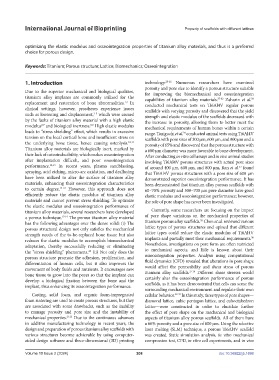Page 216 - IJB-10-2
P. 216
International Journal of Bioprinting Property of scaffolds with different lattices
optimizing the elastic modulus and osseointegration properties of titanium alloy materials, and thus is a preferred
choice for porous design.
Keywords: Titanium; Porous structure; Lattice; Biomechanics; Osseointegration
1. Introduction technology. 23-26 Numerous researchers have examined
porosity and pore size to identify a porous structure suitable
Due to the superior mechanical and biological qualities, for improving the biomechanical and osseointegration
titanium alloy implants are commonly utilized for the capabilities of titanium alloy materials. 27-32 Zaharin et al.
33
replacement and restoration of bone abnormalities. In conducted mechanical tests on Ti6Al4V regular porous
1,2
clinical settings, however, prostheses experience issues scaffolds with varying porosity and discovered that the yield
such as loosening and displacement, which were caused strength and elastic modulus of the scaffolds decreased with
3-5
by the faults of titanium alloy material with a high elastic the increase in porosity, allowing them to better meet the
modulus and biological inertness. High elastic modulus mechanical requirements of human bones within a certain
8,9
6,7
leads to “stress shielding” effect, which results in excessive range. Taniguchi et al. conducted animal tests using Ti6Al4V
34
tension on the local cortical bone and insufficient stress on scaffolds with pore sizes of 300 μm, 600 μm, and 900 μm and a
the underlying bone tissue, hence causing osteolysis. 10,11 porosity of 65% and discovered that the porous structure with
Titanium alloy materials are biologically inert, marked by a 600 μm diameter was more favorable to bone development.
their lack of osteoinducibility, which makes osseointegration After conducting in vitro cell assays and in vivo animal studies
after implantation difficult, and poor osseointegration involving Ti6Al4V porous structures with actual pore sizes
performance. 12,13 In recent years, plasma sandblasting, of around 400 μm, 600 μm, and 800 μm, Ran et al. found
32
spraying, acid etching, micro-arc oxidation, and dealloying that Ti6Al4V porous structures with a pore size of 600 μm
have been utilized to alter the surface of titanium alloy demonstrated superior osseointegration performance. It has
materials, enhancing their osseointegration characteristics been demonstrated that titanium alloy porous scaffolds with
to certain degree. 14-16 However, this approach does not 60–70% porosity and 500–700 μm pore diameter have good
efficiently reduce the elastic modulus of titanium alloy elastic modulus and osseointegration performance; however,
materials and cannot prevent stress shielding. To optimize the role of pore shape has never been investigated.
the elastic modulus and osseointegration performance of
titanium alloy materials, several researchers have developed Currently, some researchers are focusing on the impact
a porous technique. 17-19 The porous titanium alloy material of pore shape variations on the mechanical properties of
35
has the following advantages over the dense solid: (i) The titanium porous alloy scaffolds. Chen et al. reviewed various
porous structural design not only satisfies the mechanical lattice types of porous structures and opined that different
strength needs of the to-be-replaced bone tissue but also lattice types could reduce the elastic modulus of Ti6Al4V
36
reduces the elastic modulus to accomplish biomechanical implants and partially meet their mechanical requirements.
adaptation, thereby successfully reducing or eliminating Nonetheless, investigations on pore form are often restricted
the “stress shielding” phenomena. (ii) Not only does the to mechanical aspects, and little is known about their
20
porous structure promote the adhesion, proliferation, and osseointegration properties. Analysis using computational
differentiation of human cells, but it also improves the fluid dynamics (CFD) revealed that alterations in pore shape
movement of body fluids and nutrients. It encourages new would affect the permeability and shear stress of porous
37-39
bone tissue to grow into the pores so that the implant can titanium alloy scaffolds. Different shear stresses would
certainly alter the osseointegration performance of porous
develop a biological fixation between the bone and the scaffolds, as it has been demonstrated that cells can sense the
implant, thus enhancing its osseointegration performance.
surrounding mechanical environment and regulate their own
Casting, solid foam, and organic foam-impregnated cellular behavior. 40-42 In this study, three types of pore shapes—
foam sintering are used to create porous structures, but they diamond lattice, cubic pentagon lattice, and cuboctahedron
are associated with some drawbacks, such as the inability lattice—were constructed in order to elucidate further
to manage porosity and pore size and the instability of the effect of pore shape on the mechanical and biological
mechanical properties. 21,22 Due to the continuous advances aspects of titanium alloy porous scaffolds. All of them have
in additive manufacturing technology in recent years, the a 66% porosity and a pore size of 600 μm. Using the selective
design and preparation of porous titanium alloy scaffolds with laser melting (SLM) technique, a porous Ti6Al4V scaffold
various structures become achievable by using computer- was created. Static simulation analysis, in vitro mechanical
aided design software and three-dimensional (3D) printing compression test, CFD, in vitro cell experiments, and in vivo
Volume 10 Issue 2 (2024) 208 doi: 10.36922/ijb.1698

